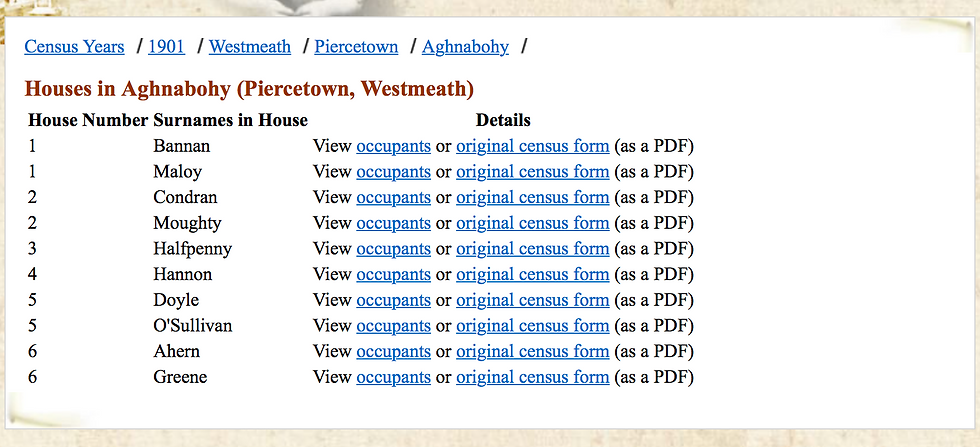IrishAncestors.ie (when you know the locality)
- moughty

- Mar 19, 2018
- 4 min read
Updated: Jul 29, 2019

Once you have identified a place in Ireland for your ancestors, one of your first stops should be at IrishAncestors.ie, a site created by John Grenham, author of Tracing Your Irish Ancestors. At RootsTech this year, I did a mini lecture in the GenealogyGems booth that focused on this site, and I was surprised by the number of people who hadn’t used it. This is not a site where you are going to type in your ancestors’ names and get information about them. It’s a site to tell you what information exists for the time and place where your ancestor lived.
Patrick Moughty was from Westmeath. Initially the family information said he was from Mullingar, however, I obtained his birth record and discovered he was from Aghnabohy. (Just as an FYI, Mullingar is in a different Civil Parish, Poor Law Union and Registrar’s district, so had this been a common name, I could have ended up researching the wrong person. Our ancestors frequently gave the name of the closest large town.) Using the Places menu I type in Aghnabohy in Westmeath and get all of the jurisdiction information.

The townland of Aghnabohy is in the civil parish of Piercetown the Poor Law Union of Ballymahon and the Registrar’s district of Ballymore. Registrar’s district were sub-divisions that collected birth, death and marriage records and forwarded them to the Superintendent’s Registrar’s District which is the same as the Poor Law Union. When looking for civil registration records, you are looking for the Poor Law Union. So Patrick’s registration of birth lists him in Ballymahon.
Next, you want to find out what records are available. Click on the name of the civil parish, Piercetown.

This page shows the location of Piercetown on the map (note it’s on the border with Longford so you may want to be open for records across the border as well) and lists all of the adjoining parishes. It lists the common surnames in the parish as well as all of the townlands. A summary of the sources is on the top right.
This page is a gateway to multiple records. By clicking the name of the townland (Aghnabohy) it takes you to AskAboutIreland for Griffith’s Valuation.

Clicking on the Occupants button will list all of the occupiers of Aghnabohy in Griffith’s (done in Westmeath between 1853 and 1855).

I believe the Bernard Murtagh listed here is actually my Bernard Moughty. By following through the Revision Books the name is corrected when the lease passes to his son, also a Bernard. Bernard Moughty also appears in church records covering this time period in Aghnabohy. From here you can view the Griffith’s original page and maps.
Similarly, clicking on 1901 or 1911 will take you to the National Archives page of the 1901 or 1911 census where you can view the original census forms.
As you can see, IrishAncestors provides a gateway to multiple databases. One of the most valuable sections, is the upper right which provides a summary of sources available for Piercetown.

The first thing I always check is the listing for church records. There is no point of spending a lot of time trying to find a baptismal record of an ancestor if the records were not kept or did not survive.

IrishAncestors lists all of the churches, the records that exist, the dates and where they are located. As you can see from the above listing, the Roman Catholic church is Moyvore and the Church of Ireland Church is Almorita. The Roman Catholic images are available to view at the National Library site (free) for the time period from 1831-1880. These have also been indexed jointly by Ancestry and FindMyPast. Westmeath and Longford are one of the few places where Roman Catholic burial records survive and they have been very helpful for me. The church records have been transcribed by the Westmeath Heritage Centre (Dún na Sí) and are available at RootsIreland.ie (subscription). Note that the transcriptions go to 1920. The records for the Church of Ireland were mostly destroyed in the 1922 fire, however marriages from 1845 (which is when civil registration of marriages began Protestants) and some burial records have also been transcribed.
You should check all of the other categories to see what records exist for this area. Census and Census Substitutes will list chronologically surviving records. Some of these records will cover just a small part of the population or will only be available in Ireland so it’s important to review the lists before you visit.

IrishAncestors is a subscription site, and subscriptions are available for 24 hours, monthly or yearly. Since I use this site every day, I have an annual subscription. Many of the browse features are free, but when you make five requests for data in 24 hours, you’ll be asked to subscribe. Signing up for 24 hours or a month is well worth it! You can also sign up to receive John’s free weekly blog, always a treat, although I usually share it on my Facebook and Twitter pages.
Next week I’ll discuss some other features of IrishAncestors which might be helpful if you only know the county where your ancestors lived.
Happy Hunting!




Comments